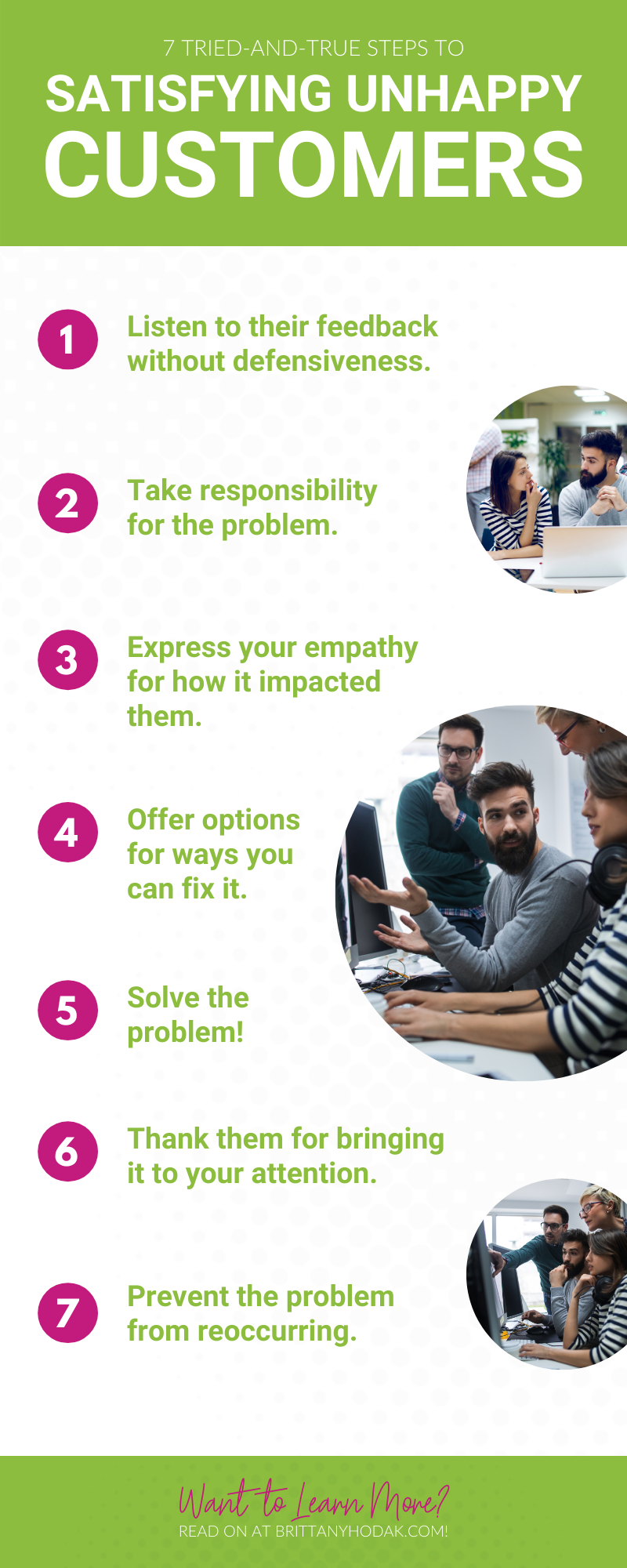We’re all familiar with the phrase “the customer is always right,” but this doesn’t really help us in the heat of the moment. Not only are customers not always right, but they sometimes can be difficult to please. Learning how to satisfy unhappy customers and turn the situation around is key to creating a customer-first business.
When things go wrong, it’s easy to get defensive. It’s only human instinct to respond with frustration and to deflect blame. Though it takes some practice, learning how to take responsibility, express empathy, and solve the problem goes a long way.
Your customers just want to feel heard and understood. At the end of the day, they just want to find a solution—and this should be something that works for both parties. With a reported 95% of consumers saying customer service is important to brand loyalty, you can’t afford to ignore this vital aspect of running a business.
Though it might sound counterproductive, this is a phenomenon known as the service recovery paradox. This means that when things go wrong, you actually can strengthen your customer relationship by making things right efficiently and effectively. In this guide, we’ll share 7 tried-and-true steps to satisfying unhappy customers.
- 1. Listen to their feedback without defensiveness.
- 2. Take responsibility for the problem at hand.
- 3. Express your empathy for how the problem impacted them.
- 4. Offer options of ways you can make things right.
- 5. Solve the problem!
- 6. Thank them for bringing this matter to your attention.
- 7. Prevent the problem from recurring.
- Turn Around Unhappy Customers
1. Listen to their feedback without defensiveness.
First and foremost, always listen. Even if you already anticipate what they’ll say next, let them express themselves in their own words. When customers are angry or frustrated, they typically just want to feel heard.
Though listening to feedback can be difficult, avoid meeting this frustration defensively. Regardless of who is at fault, keep an open mind. Be an active listener, concentrating on what the customer is actually saying. More importantly, think about the emotions behind their words and try to understand where they’re coming from.
For example, if a customer is sharing their frustration at receiving a product late, it could be tempting to get defensive about shipping delays that are outside of your control. Instead, be an active listener.
Respond with something like, “I understand that you’re frustrated that your gift for your husband arrived late. That sounds like it really messed up your plans.” This type of phrase shows that you not only listened to what they said, but you actually interpreted the emotions behind their words. This is the first (and most essential) step for satisfying unhappy customers.
2. Take responsibility for the problem at hand.
Next, be prepared to take responsibility. It doesn’t matter if you personally caused the problem or no one did, never play the blame game. When you deflect blame, nobody wins, and the customer only feels ignored. Simply accept the full blame, and don’t offer any excuses.
Too many brands struggle with taking responsibility. A reported 88% of consumers are less likely to make purchases from companies that don’t address concerns or accept responsibility. Here’s how to take responsibility:
- Accept fault: Recognize that apologizing doesn’t mean you’re 100% wrong and the customer is right. It means you value your relationship.
- Timely: You should always offer an apology quickly and in a timely manner. There should be no dancing around it.
- Explain: If possible, share what went wrong. For example, if shipping was delayed, explain that this is an issue you’re actively working on, though you know it’s frustrating.
- Avoid excuses: Lastly, never make excuses. If your apology reads, “I’m so sorry, but…” then it isn’t cutting it. You don’t need any ‘but’ statement, so just stick to your apology.
The streaming service Disney+ does a great job of this on Twitter. They quickly apologize with every concern, and they don’t play the blame game no matter the issue. Not only does this give the customer a solution faster, but it improves the brand’s reputation as a customer service superstar.
3. Express your empathy for how the problem impacted them.
Moreover, express empathy with the customer. When trying to satisfy unhappy customers, you need to show them that you understand their feelings. Empathy should always be a guiding principle within your brand, and it’s what sets some providers apart from the competition.
However, use the right definition of empathy. To be empathetic doesn’t mean you blindly agree with the customer. It just means understanding how they really feel. Not only does this mean you can relate to them on a personal level, but you can also de-escalate challenging interactions.
Respect is at the heart of empathy. The right language expresses this connection to customers, and it shows you really understand. Here are some phrases you might use:
- “I realize how complicated this process is…”
- “I know how confusing it must be…”
- “I’m really sorry to hear that…”
- “I understand how frustrating it is…”
- “That sounds really upsetting…”
Once you connect with customers through empathy, you’re ready to make real change. This is where the service recovery paradox comes into play. Finally, you’re ready to turn the situation around for good.
4. Offer options of ways you can make things right.
Aside from wanting to feel heard, your customer wants a real-world solution to their problem. While you might have a single solution you offer if something goes wrong, it’s best to offer multiple options. Your customer wants to feel in control, especially after a bad experience. Letting them choose the solution that works best for them is a great option.
However, what happens when your customer isn’t always right? If they suggest something that isn’t possible, it’s time to compromise. Collaboration is key to resolving these issues, so you might need to escalate the issue to a more senior manager. Always keep lines of communication open, and let your customer know what you can do right away to help.
Whether you offer a discount, send a new product, or provide tech support, work with the customer to find what’s right. If you don’t know what they need, the answer is simple: ask them. Many times they ask for something completely reasonable and within your power, so don’t complicate the situation.
5. Solve the problem!
Next, it’s time to solve the problem. Now that you’ve come to an agreement with the customer about the right course of action, follow through. If that means escalating the issue or taking it to another department, do just that.
Most importantly, solve the problem as quickly as possible. A reported 33% of customers are the most frustrated by wait times, especially when that means having to repeat themselves to different support staff. The more efficient the process, the better.
One company that does this right is the ecommerce giant Amazon. They make getting help as easy as clicking a button and connecting an agent. While most basic concerns can be handled through their AI assistant, Amazon requires their sellers to respond to messages within 24 hours to keep up with customer expectations.
6. Thank them for bringing this matter to your attention.
Above all, you want to thank your customers for taking the time to talk to you. In fact, 91% of customers who are unhappy with their experience will leave without complaining. This means that for every complaint you get from unhappy customers, countless others who feel the same say nothing.
Though these responses might be frustrating, they’re truly an opportunity for growth. For example, you might learn that there’s an area in your business that needs improvement. Whether you have unexpected fees, confusing information on your checkout page, or packaging issues, this is a chance to do better.
Always take a moment to thank your customer for taking time out of their schedule to contact you. This ends your interaction on a positive note, and it once again ensures they feel valued. Saying something like, “Thank you for sharing your experience with our product” goes a long way. Not only are they likely to contact you again if there’s an issue (vs. taking their complaints online), but you build a stronger relationship.
7. Prevent the problem from recurring.
Lastly, prevent the problem from happening again. Unhappy customers are an opportunity to learn. Your customers are your greatest asset, but you need to learn from them if you expect to improve your overall experience.
Share this feedback with other members of your team. From product managers to tech engineers, it’s important to collaborate on ways to do better. If you can, share how you plan to do better with the customer before you close your conversation.
For instance, you might say something like, “Thank you for sharing feedback about our checkout page. I’ll share this with our development team to see how we can make it easier to use.”
The average American tells 15 people when they have a poor customer service experience. This means taking a proactive approach to your brand experience is a must. If you want to create superfans, you need to anticipate customers’ needs (proactive instead of reactive).
Turn Around Unhappy Customers
If you’re trying to satisfy unhappy customers, don’t reinvent the wheel. While angry, unhappy customers might not be the easiest to interact with, give customers a space to share their frustrations. By facing these concerns with patience and empathy, you have the opportunity for real-world growth.
As a brand, it’s important to respect the opinions of your customers. If any customer takes the time to reach out to your team directly, give them the attention they deserve. Not only will you build stronger relationships, but you can improve your overall experience for customers in the future.






